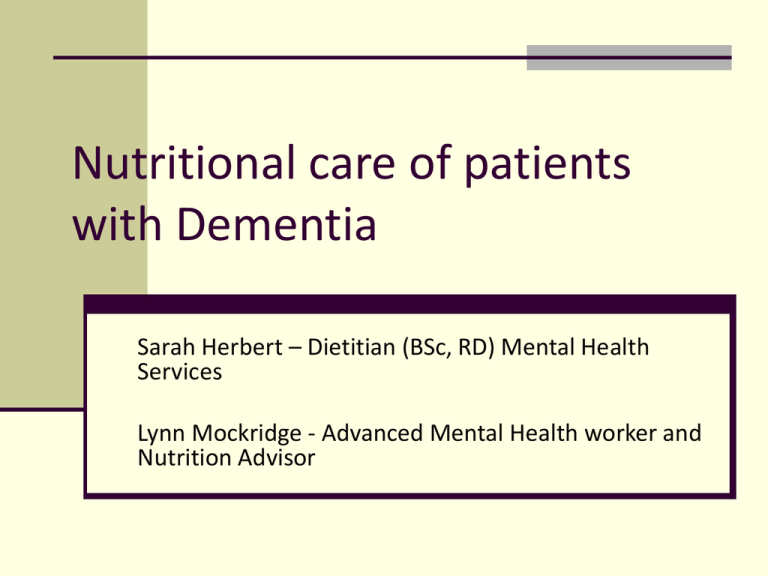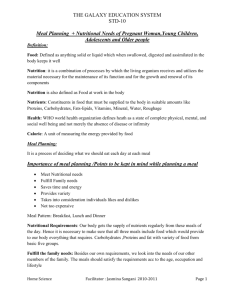Nutritional care of patients with Dementia
advertisement

Nutritional care of patients with Dementia Sarah Herbert – Dietitian (BSc, RD) Mental Health Services Lynn Mockridge - Advanced Mental Health worker and Nutrition Advisor Contents Introduction Dementia Effects of dementia on nutritional status Practical advice – support with eating and drinking Nutritional therapy in Dementia Quiz Questions Introduction Based at Callington Road Psychiatric Hospital Long, enduring mental health conditions Intensive care, acute, rehabilitation and elderly (one organic, one functional) units Team of four; three Dietitians, one Nutrition Advisor/Advanced MH worker Dementia Dementia describes a number of conditions in which there is a progressive loss of brain function. About 750,000 people in the UK have dementia and this number is expected to double in the next thirty years (DoH, 2012) As Dementia progresses, so does an individual’s ability to eat and drink resulting in a decline in nutritional status. Effects of Dementia on nutritional status Early stages – weight gain? Poor appetite and dehydration Weight loss Re-feeding syndrome Increased nutritional requirements Vitamin and mineral deficiencies G.I disturbances from medication may affect appetite What are the common difficulties with eating and drinking? Decreased ability to recognise hunger and satiety Lack of recognition Food preferences may change Challenge to communicate likes and dislikes. Cutlery may become difficult to use or forgotten how to be used Motivation Concentration Preparing/cooking food may become difficult Environmental issues: inpatient facilities. Dexterity issues (manual and mental) Preparing for a meal Encourage the person to go to the toilet before meals if needed Making sure glasses or dentures are in place for the meal Consider using adapted cutlery Use plate warmers to help keep food warm Use contrasting coloured plates Avoid distracting items on the meal table Ensure good oral hygiene after eating Taste changes Try naturally sweet vegetables Use sweet and sour sauces Add honey to vegetables Add a little sugar to mince, stew or potatoes Encourage milk-based puddings such as: Refusal of food previously accepted Strong flavoured foods, spicy foods or previously disliked foods may now be enjoyed Keep an open mind, don’t exclude any foods Keep a list of current preferences Try adding additional spices, herbs, onion, garlic, chilli Avoid adding extra salt Offer table sauces – chutney, pickle, relishes, vinegar, mustard What if someone struggles to finish a meal? Allow extra time for meals as needed Serve one course at a time to keep food warm Prompting/Reassuring Dish up a small amount of food at any one time Consider offering 5-6 small snacks during the day rather than 3 main meals Avoid removing plate early in an inpatient/care home setting Wandering/distraction at mealtimes Leave out snacks along the route the person walk or place foods in their hand to prompt Try a variety of finger foods Encourage high energy foods where possible Change the environment Change mealtimes to suit the person Food fortification Don’t add extra foods but concentrate with energy and protein 5-6 small meals/snacks instead of 3 larger meals per day Avoid low calorie/reduced fat foods Add extra butter, cheese, cream, sugar to foods Spread jam/honey thickly onto toast/crumpets Fortify full cream milk by adding 2tbps of milk powder Quiz! Thanks for listening! We hope you enjoyed it and found it helpful








